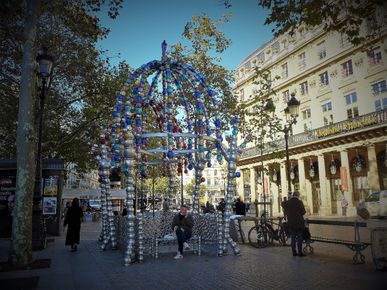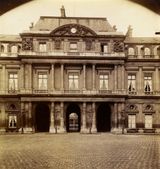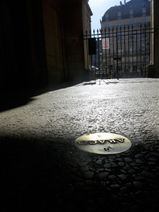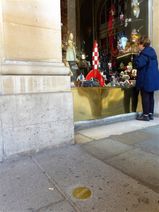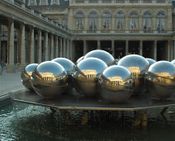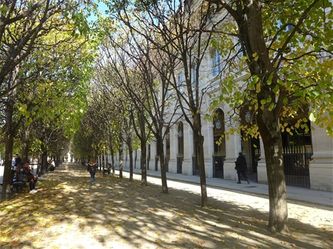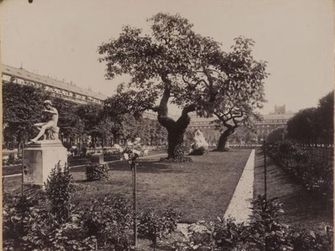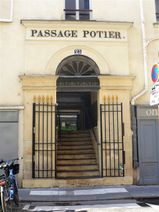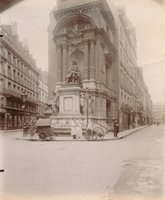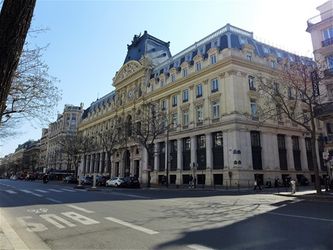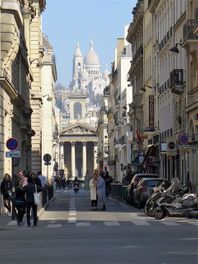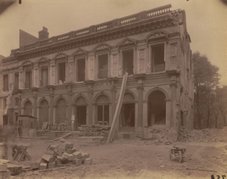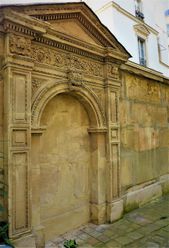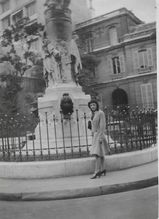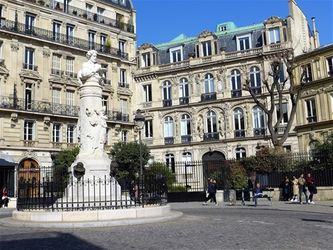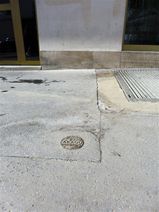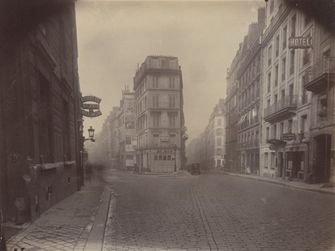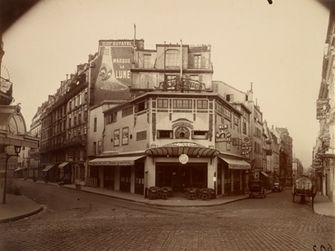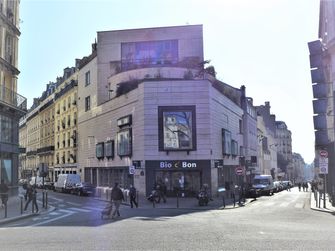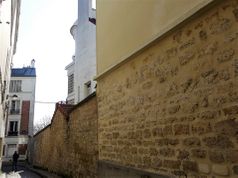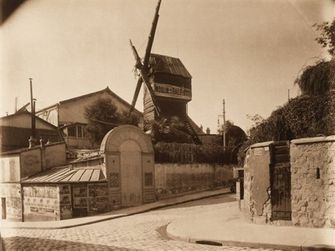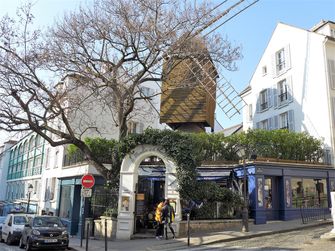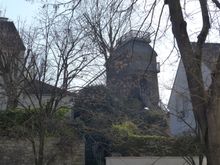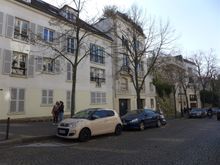Hora fugit - Un peu de Paris
Paris Meridian - From Palais Royal to Montmartre
This last stroll along the former Paris Meridian line goes from the Palais Royal to Montmartre.
Place Colette
In front of us, two French institutions, the Council of State and the Theatre Company the Comédie Française.
The metro station, with its colorful Murano glass globes is quite in contrast with these classical buildings. This piece of art by Jean-Michel Othoniel is an invitation to poesy and dream.
Palais-Royal - Galerie de Nemours
Palais-Royal - Square and facade (Now Council of State)
Atget (Musée Carnavalet)
Let's enter into Palais-Royal, following the Galerie de Nemours, which goes around the theatre. On our right , the café Le Nemours is a perfect meeting point. The sparrows, now a rare sight, can still be seen here on the terrace, from which the spectacle is permanent: the incessant ballet of the birds, attracted by the crumbs, the comings and goings of numerous passers-by and of few personalities.
Several Arago medallions confirm we are walking along the former Paris Meridian line.
Palais-Royal - Galerie de Chartres
We continue through the Galerie de Chartres, leading to the Cour d'Honneur of the Palais Royal, with its famous Buren's Columns, so controversial when they were built.
Now, we are rather used to the 260 black and white marble Columns so perfectly aligned. They look to me like a giant game board; its pieces being the young kids standing on them and the less young ones seating on them.
Palais Royal - Cour d'honneur
I still remember the wonder I had here once as a child at the sight of the Comedians of the theatre. With a white ruff around their necks, a sword at their sides, a cigarette in mouth for some of them, they were standing outside on a balcony of the first floor of the Theatre. It was a Sunday afternoon. The air was filled with their laughter in the cold and deserted galleries. It was at the end of the 1960s. At that time, the Palais Royal was quite a deserted garden. The scandalous columns were not yet there, the Pol Bury's fountains with their huge silver balls mirroring the galleries were not yet there…
Palais-Royal - Garden
As it is quite a withdrawn passage away from the traffic, I also included the Palais-Royal garden in the stroll of the Covered Passages.
It is a majestic and calm green place though now frequented at all hours of the day. Not like in the past, at the time of the French writer Colette who often described it. At her time, the Palais Royal, little known and secluded, was only frequented by the locals. Its old-fashioned look was reinforced by the shops of an other era, selling objects for boys: medals, tin soldiers, pipes… You still can see them in the Galerie de Chartres. But, they are now more and more overshadowed by the very chic boutiques of the Galeries de Montpensier and Valois.
Palais-Royal - Cannon
We now continue through the Galerie de Montpensier along the left side of the garden. Let's stop just behind the statue of The Snake Charmer, still charming though his left arm and the snake are both gone. In the middle of the lawn, on a concrete plinth is a tiny Cannon.
In 1786, a clock maker, owner of a shop in a gallery of the Palais-Royal had the idea to install a tiny meridian cannon. Fitted with a glass lens and a fuse, the cannon was fired when the midday sun was hitting the glass. When the Greenwich Meridian became the official reference in 1911, the cannon was silenced, a few tears before more terrible ones fired in the whole world. It was used from time to time until it was stolen in 1998. Once a week, at midday on Wednesdays, a replica of the cannon was fired.... manually!
Palais-Royal - Garden
Atget
(Musée Carnavalet)
Galerie de Montpensier
Let's go back to the Galerie de Montpensier where we will find an exit to the rue de Montpensier where a small passage at n° 23 will take us to the rue de Richelieu.
Rue de Richelieu
In front of 24 rue de Richelieu, an Arago medallion should indicate the right direction to take, i.e. north, towards the Molière fountain. (Be careful, it has been wrongly repositionned!).
This massive fountain represents the famous French playwright sitting in an armchair above two statues representing the Serious Comedy and the Light Comedy. Molière died after a performance of the Imaginary Invalid in Februray 1673, not far from here, at his home located at 40 rue de Richelieu.
To now reach the Boulevard des Italiens, we will follow the Rue des Petits-Champs, then the Rue Sainte-Anne and finally the rue de Gramont. On your way rue Sainte-Anne, you may want to take the time to stop at the handsome Olivier Roellinger's spice shop .
Molière fountain
rue de Richelieu
Atget – 1906
(BnF)
Boulevard des Italiens
In the 19th century, the Boulevard des Italiens was the high fever pulse of the Parisian microcosm. All the characters so well described by Honoré de Balzac, the social painter of the Human Comedy could be seen there crossing their paths in fashionable cafes and theatres: aristocrats, courtesans, writers, artists, journalists, … Although its aura has somehow faded today, it is still a very popular thoroughfare for its restaurants, cinemas, theatres and covered passages.
he Credit Lyonnais building, quite massive like many other banking establishments were opened in this district during the 19th and 20th centuries.
On the opposite side between rue Taitbout and rue Lafitte, an other bank, the BNP building has an impressive neo-renaissance facade. Created in the 19th century, the building was a famous restaurant, and as a very luxury and expensive place, got the nickname of the Gilded House.
I remember when it was turned into a modern building in the 1970s. Only its facade was kept and its structure completely hollowed out.
Have a look at the carved frieze. Among the many animals, there is a wolf contemplating a little lamb … An image quite appropriate for a bank, isn't?
Rue Laffitte
Let's continue along rue Lafitte to rue de Châteaudun. In front of us, the Sacré-Coeur at the top and below, the church of Notre-Dame de Lorette, where I received baptism and communion like my mother. Externally, the church which suffers from deterioration looks quite simple; but its interior with its gilded ceiling is richly decorated with marble and paintings.
Laffitte was a banker and the activities in this street are indeed devoted to the banking industry. James de Rothschild, an other famous banker, received « le Tout Paris » of the early 19th century in his mansion at 19 of this street. His diners were prepared under the direction of Antonin Carême, « the King of chefs and the chef of kings ».
Carême is also known for a famous dish he would have created for the musician Rossini. The Tournedos Rossini is made from filet-mignons topped with a slice of foie gras and garnished with slices of black truffle.
James de Rothschild's brother, Salomon de Rothschild, was his neighbour with a private mansion at 17, rue Laffitte.
Previously, Hortense de Beauharnais, Queen of Holland and wife of Louis Bonaparte, Napoleon's brother, lived in this mansion, where she gave birth to the future Napoleon III. The mansion was demolished in 1900 to create Rue Pillet-Will, austere and cold like the offices of the Insurance Company which border it.
The Palace of the Queen Hortense
Rue Laffitte
Atget – 1899/1900
(INHA)
34, rue de Châteaudun
Before continuing along rue Saint-Georges, I stopped at 34, rue de Châteaudun, looking for a possible Arago medallion.
There was no medallion, neither outside, nor in the courtyard of this elegant private mansion, a listed building. Formerly used by the Ministry of Education, it is now occupied by a day nursery and social homes. Instead of a medallion, I discovered a charming place in front of which I had passed so many times without even really paying attention. When young, we do not always capture the beautiful things of the past.
In the courtyard, I found this elegant listed fountain, from a time when running water was not yet provided.
Place Saint-Georges
Rue Saint-Georges, I enter my childhood neighbourhood, where my grandparents settled in the 1930s.
We now arrive place Saint-Georges, where there is the monument to the memory of the illustrator Gavarni. My hubby took a picture of me at the foot of the monument where my grandmother was photographed in the thirties by her hubby too. What a strange feeling , I was kind of communicating with her through the past. A communication with a weird inversion of time. Me, a Grandma today, meeting with the spirit of my grandmother, her then a pretty and elegant young woman in the 1930s.
We are in the Nouvelle Athènes district, built at the beginning of the 19th century, a pretty and quiet precinct where I spent my first twenty years.
It received the name of Nouvelle Athènes (New Athens) from the neo-classical style of the new buildings, such as the church of Notre-Dame de Lorette. It also received this name from the community of prestigious artists inspired by Antiquity who settled there.
On Rue Chaptal, the painter Ary Scheffer had his studio and house, today the Museum of the Romantic Life, where George Sand, Chopin, Delacroix, Ingres, Liszt met ...
On Rue de la Rochefoucauld, the symbolist painter Gustave Moreau had his private mansion there, today a beautiful museum.
As a new fashionable district in the 19th century, it attracted all kinds of single young women: from prostitutes dubbed lorettes after the nearby Notre Dame de Lorette church to courtesans, such as la Païva, who acquired this luxurious mansion at Place Saint-Georges easily recognisable by its extravagant Renaissance style facade.
Rue Pigalle
Let's continue along rue Notre-Dame de Lorette to rue Jean-Baptiste Pigalle on the right.
I was quite surprised to discover that an Arago medallion is still there at 69-71 rue Pigalle. As surprised than the young guy waiting there in a long queue at Dumbo, looking at me while I was taking a picture of the medallion, quite insignificant to him. As insignificant to me than this Dumbo, that I discovered being THE new smash burger high spot in Paris. No … Arago is not a new game ... But after few explanations, I saw his eyes sparkling when he realised the Paris meridian line was just in front of his favourite burger address. Our two different worlds were finally connecting ...
Rue Pigalle – April 1925 at 6 AM
Atget
(MoMA)
Place Pigalle
We are now at Place Pigalle, a notorious red-light district, an area changing with new organic shops and a project to redevelop the square. Like other areas of Paris, gentrification is hitting the district which has been re-branded to a new name: So Pi (South Pigalle) ... so trendy ...
The whole Nouvelle Athènes district is impacted by this phenomenon of gentrification, a new word for population sanitation. The old shops of the rue des Martyrs of my childhood, of quality, but simple have been replaced by new and fashionable shops. Rue Clauzel, the building where I grew up has also improved considerably; the old carpet shop next door has been dusted off making way for a little fashionable vintage shop ... As my mother says, better to prefer to see the glass as half full!
Place Pigalle
Atget – 1925
(Paul Getty Museum)
The history of the café de La Nouvelle Athènes illustrates perfectly the evolution of the Pigalle district:
Created at the end of the 19th century, the café was where many painters, writers and girls hung-out. Degas's famous painting « Absinthe » was painted there.
Then, it was replaced in the 1920s, by a restaurant, the Loup Garou with an establishment upstairs, the New Monico where people were dining and dancing. This is the place that Atget photographed in 1925.
In the 1950s, it became a strip club, called the Narcisse. Its neon sign appears often in French crime films of the 1950s, such as du Rififi chez les hommes (rififi a slang term for trouble), a very good movie showing many other Paris locations.
And today, it is an organic shop in the gentrified centre of So Pi.
Rue André Antoine
Let's cross the boulevard de Clichy and take the rue André Antoine, a small winding street with steep steps leading to the rue des Abbesses.
We are reminded by the large country house at the end of the first section of the street that this was once a village. There I met a charming local old lady, amazingly small for her Swedish origin due to her other half Pyrenees mountains origins. She was quite excited to speak about her street, her smiling face lit up by deep blue eyes. First, this country house, do you know why this house was called a folly ? because foleia in Latin means feuilles (leaves) and that this kind of house was surrounded by a garden.
She continued, do you know who was André Antoine? As a theatre man, he was the creator of modern performance and staging; indeed, he caused a scandal by hanging real carcasses of beef for the play The Butchers in 1888, in his Théâtre-Libre de Montmartre, located on this street.
The second section of the street is crowded with terraces on sunny days. And then steep steps lead to the lively rue des Abbesses, where we turn left.
Bateau-Lavoir
We then turn right into Rue Ravignan, which leads to the pretty cobbled square of Emile Goudeau, and to the famous Bateau-Lavoir.
It was an old wooden building divided in 1889 by its owner into ten studios with no comfort, no running water, no gas, no electricity. It disappeared in a big fire in 1970. New twenty-five studios were rebuilt in 1978.
Picasso spent five years there from February 1904 to 1909; When he settled at the Bateau-Lavoir, it was after his blue Period paintings, he was still a cursed twenty-four year old painter. He produced here the entire Pink Period paintings, using the colours of his love for the beautiful Fernande. He painted here the Demoiselles d'Avignon, both starting points of Cubism and of his consecration.
Other famous artists of this period could be seen in the Bateau-Lavoir: Van Dongen, Derain, Modigliani, Juan Gris, Max Jacob, Pascin, Braque, Matisse, Apollinaire, Cocteau...
Rue d'Orchampt
Let's turn left into rue d'Orchampt where at number 1, we can see two original studios of the Bateau Lavoir which did not disappear in the fire.
At the level of a high white house where lived Dalida, a famous French famous singer, the street is suddenly bending and changing. Becoming narrow, with a long doorless wall, it appears kind of mysterious. No wonder that the writer Marcel Aymé chose it at the home of "that excellent man named Dutilleul who had the singular gift to walk through walls without any trouble ». Of course, his address, 75bis rue d'Orchampt does not exist in reality.
A little further on, at the corner of Rue Norvins, this poor Dutilleul can be seen, stuck in the wall. The sculpture, designed by the talented French actor Jean-Marais is both representing the writer and the passer through walls (le Passe Muraille).
Moulin du Radet
We have now arrived on rue Lepic just in front of the Moulin du Radet (Other stroll in Montmartre).
The two Montmartre's last mills , the Blute-Fin and the Radet, have their wings stuck forever too, like the poor Dutilleul. Both were alternatively named Moulin de la Galette, but it was the Blute-Fin that Renoir painted.
Radet mill - Bal du Moulin de la Galette
rue Lepic
Atget – 1899
(Site Vergue)
Blute Fin mill - Avenue Junot
Let's take the Rue Girardon and turn onto the Avenue Junot, from where we can see the back of the Blute-Fin mill. This is where the North obelisk (Mire du Nord), was installed by Jacques Cassini in 1736, to align the Paris Meridian line on the northern side with the Observatory in the south. Located in a private garden, it cannot be seen.
The very chic avenue Junot lines luxurious private mansions. Before the First World War, it was a sort of shanty town, known as the Maquis (Scrub). Like on many paintings by Utrillo, we can see on Atget's photo the small huts and gardens at the foot of the Moulin de la Galette.
Montmartre – Moulin de la Galette
Atget – 1899/1900 -
(MoMA)
Let's cross Avenue Junot to enter the public garden. Legend has it that a holy fountain erupted here at the place where Saint-Denis washed his cut head. For a long time, the fountain was an important point of pilgrimage, until it disappeared into a plaster quarry in 1810.
We exit the garden rue Simon Dereure which leads back to avenue Junot.
At 45-47 avenue Junot, the expected Arago medallion is gone.
A French humorist Pierre Dac, lived at number 49. He did not loose his head, neither the north to find some basic answers to the human condition : "Who are we ? Where do we come from ? Where are we headed ? my answer is as follows : As for me, personally, well, I’m me, I’ve come from home, and that’s where I’m headed."
If you wish, the stroll can end here and if you are headed to go home, you will reach the Lamarck-Caulaincourt metro station by using the stairs of rue Pierre Dac.
I did the last part of the stroll up to the avenue of Porte Montmartre, I would say that it is not worth it. Especially beyond the Rue de la Fontaine du But and Rue du Ruisseau (stream), which take their names from the stream of the miraculous fountain.
Texte / Photos : Martine Combes
Contact / newsletter:

